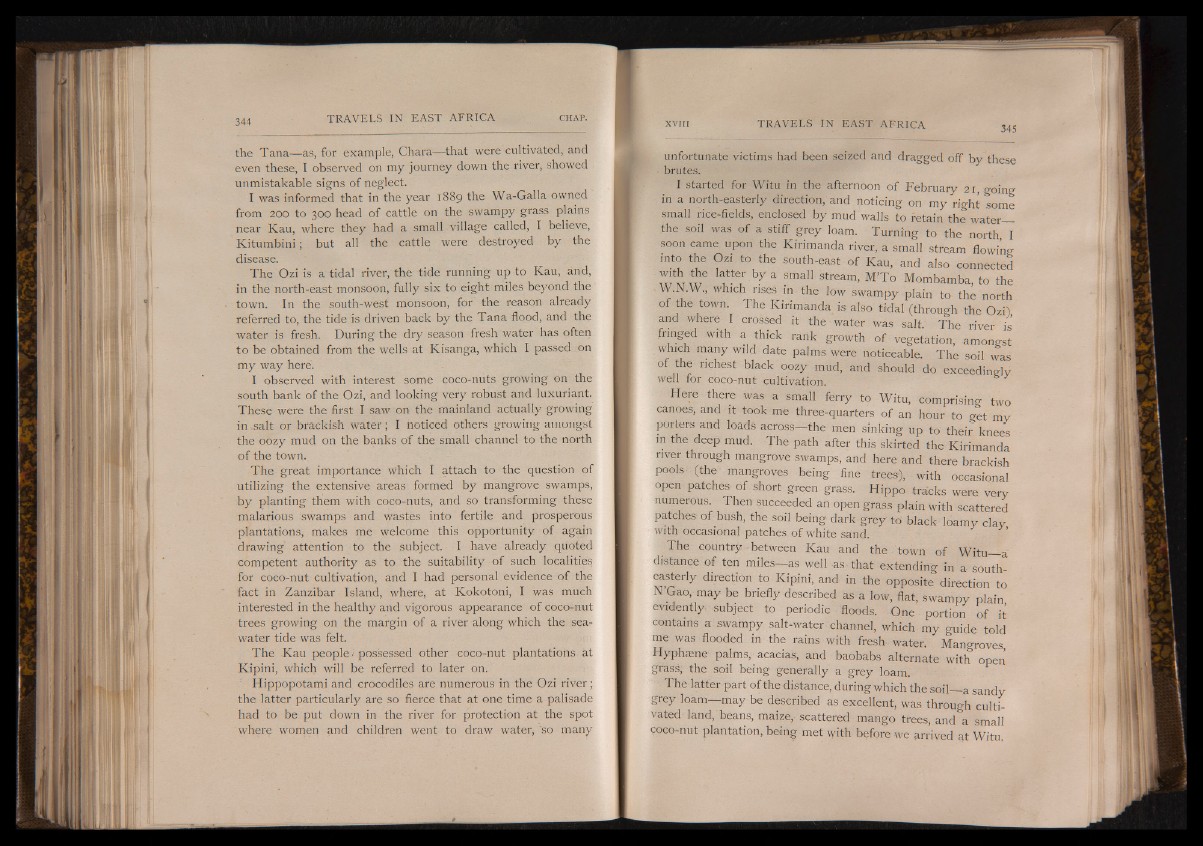
the Tana— as, for example, Chara— that were cultivated, and
even these, I observed on my journey down the river, showed
unmistakable signs of neglect.
I was informed that in the year 1889 the Wa-Galla owned
from 200 to 300 head of cattle on the swampy grass plains
near Kau, where they had a small village called, I believe,
Kitumbini; but all the cattle were destroyed by the
disease.
The Ozi is a tidal river, the tide running up to Kau, and,
in the north-east monsoon, fully six to eight miles beyond the
town. In the south-west monsoon, for the reason already
referred to, the tide is driven back by the Tana flood, and the
water is fresh. During the dry season fresh water has often
to be obtained from the wells at Kisanga, which I passed on
my way here.
I observed with interest some coco-nuts growing on the
south bank of the Ozi, and looking very robust and luxuriant.
These were the first I saw on the mainland actually growing
in salt or brackish water; I noticed others growing amongst
the oozy mud on the banks of the small channel to the north
of the town.
The great importance which I attach to the question of
utilizing the extensive areas formed by mangrove swamps,
by planting them with coco-nuts, and so transforming these
malarious swamps and wastes into fertile and prosperous
plantations, makes me welcome this opportunity of again
drawing attention to the subject. I have already quoted
competent authority as to the suitability of such localities
for coco-nut cultivation, and I had personal evidence of the
fact in Zanzibar Island, where, at Kokotoni, I was much
interested in the healthy and vigorous appearance of coco-nut
trees growing on the margin of a river along which the seawater
tide was felt.
The Kau people / possessed other coco-nut plantations at
Kipini, which will be referred to later on.
Hippopotami and crocodiles are numerous in the Ozi river;
the latter particularly are so fierce that at one time a palisade
had to be put down in the river for protection at the spot
where women and children went to draw water, so many
unfortunate victims had been seized and dragged off by these
brutes.
I started for Witu in the afternoon of February 21, going
in a north-easterly direction, and noticing on my right some
small rice-fields, enclosed by mud walls to retain the water—
the soil was of a stiff grey loam. Turning to the north, I
soon came upon the Kirimanda river, a small stream flowing
into the Ozi to the south-east of Kau, and also connected
S i f S B ? a small-stream, M’To Mombamba, to the
W.N.W., which rises in the low swampy plain to the north
of the town. The Kirimanda is also tidal (through the Ozi!
and where I crossed it the water was salt. The river is
fringed with a thick rank growth of vegetation, amongst
which many wild date palms were noticeable. The soil was
of the richest black oozy mud, and should do exceedingly
well for coco-nut cultivation.
Here there was a small ferry to Witu, comprising two
canoes, and it took me three-quarters of an hour to get my
porters and loads across— the men sinking up to their knees
in the deep mud. The path after this skirted the Kirimanda
river through mangrove swamps, and here and there brackish
pools-(the mangroves being fine trees-), with occasional
open patches of short green grass. Hippo tracks were very
numerous. Then succeeded an open grass plain with scattered
patches of bush, the soil being dark grey to black loamy clay
with occasional patches of white sand.
The country between Kau and the town of Witu a
distance of- ten miles— as well as that extending in a southeasterly
direction to Kipini, and in the opposite direction to
N’Gao, may be briefly described as a low, flat, swampy plain
evidently subject to periodic floods. One ■ portion of it
contains a swampy salt-water channel, which my guide told
me was flooded in the rains with fresh water. Mangroves
Hyphaene palms, acacias, and baobabs alternate with open
grass, the soil being generally a grey loam.
The latter part of the distance, during which the soil— a sandy
grey loam— may be described as excellent, was through cultivated
land/beans, maize, scattered mango trees, and a small
coco-nut plantation, being met with before we arrived at Witu